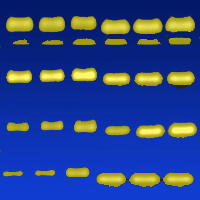
Real-Time PCR for Ceratocystis platani detection: in-depth validation to assess the diagnostic potential and include additional technical options
Valentina Lumia (1), Vanessa Modesti (1), Angela Brunetti (1), Cinthia L Wilkinson (2), Giovanni Di Lernia (1), Thomas C Harrington (2), Massimo Pilotti (1)
iForest - Biogeosciences and Forestry, Volume 11, Issue 4, Pages 499-509 (2018)
doi: https://doi.org/10.3832/ifor2527-011
Published: Jul 18, 2018 - Copyright © 2018 SISEF
Research Articles
Abstract
A high-performing detection method is essential to safeguard those countries that are still unaffected by canker stain, a devastating disease of Platanus spp. caused by Ceratocystis platani. We previously developed EvaGreen and Taqman-based Real-Time PCR to detect this pathogen, but in-depth validation is needed to guarantee users about its effectiveness and promote its utilization. In this work we present a validation study designed according to EPPO standards, focusing on the analytical and diagnostic sensitivity and specificity. We extend its technical application using SYBR Green. By performing standard curves and eight-replication-based experiments, we established the detection limit at 3 fg C. platani gDNA per PCR reaction. The repeatability and the operator-based reproducibility of the Real-Time PCR was demonstrated. Different gDNA extraction events by different operators and different gDNA extraction modalities did not affect the detection limit. The detection limit threshold cycle was earliest with SYBR Green, followed by Taqman, and EvaGreen. Spiking 6 µl DNA extractions of uninfected, necrotized wood with 3 fg C. platani gDNA confirmed the detection limit: 3 fg C. platani gDNA per PCR reaction, i.e., 0.5 fg gDNA per µl of wood extract. The assays tolerated 6 µl of necrotic C. platani-infected wood extracts without inhibition except for long-dead wood samples, while the 2 µl dose consistently allowed for successful detection. Detection of the pathogen in infected samples showed the highest diagnostic sensitivity with the SYBR Green assay. Agarose gel electrophoresis and staining was validated for visualizing amplicons, even at the detection limit. The specificity of the method was tested against 23 isolates representing the diversity of Ceratocystidaceae, and most species were not detected at 5 ng gDNA. However, some South American strains of the C. fimbriata complex were detected at doses as low as 5 fg. The method remains specific for C. platani detection as no other Ceratocystidaceae are known to colonize plane tree and the species within the geographic range of canker stain of plane tree were only detected at 500 pg or more gDNA. This work paves the way for a performance study of inter-laboratory comparisons.
Keywords
Canker Stain, Real-Time PCR, Validation, EvaGreen, Taqman, SYBR Green
Authors’ Info
Authors’ address
Vanessa Modesti
Angela Brunetti
Giovanni Di Lernia
Massimo Pilotti
Research Centre for Plant Protection and Certification (CREA-DC), Consiglio per la ricerca in agricoltura e l’analisi dell’economia agraria, v. C. G. Bertero 22, I-00156 Rome (Italy)
Thomas C Harrington
Iowa State University, Department of Plant Pathology and Microbiology, 1344 ATRB, Ames, IA 50011 (USA)
Corresponding author
Paper Info
Citation
Lumia V, Modesti V, Brunetti A, Wilkinson CL, Di Lernia G, Harrington TC, Pilotti M (2018). Real-Time PCR for Ceratocystis platani detection: in-depth validation to assess the diagnostic potential and include additional technical options. iForest 11: 499-509. - doi: 10.3832/ifor2527-011
Academic Editor
Alberto Santini
Paper history
Received: Jun 19, 2017
Accepted: May 15, 2018
First online: Jul 18, 2018
Publication Date: Aug 31, 2018
Publication Time: 2.13 months
Copyright Information
© SISEF - The Italian Society of Silviculture and Forest Ecology 2018
Open Access
This article is distributed under the terms of the Creative Commons Attribution-Non Commercial 4.0 International (https://creativecommons.org/licenses/by-nc/4.0/), which permits unrestricted use, distribution, and reproduction in any medium, provided you give appropriate credit to the original author(s) and the source, provide a link to the Creative Commons license, and indicate if changes were made.
Web Metrics
Breakdown by View Type
Article Usage
Total Article Views: 49330
(from publication date up to now)
Breakdown by View Type
HTML Page Views: 41710
Abstract Page Views: 3206
PDF Downloads: 3458
Citation/Reference Downloads: 6
XML Downloads: 950
Web Metrics
Days since publication: 2702
Overall contacts: 49330
Avg. contacts per week: 127.80
Citation Metrics
Article Citations
Article citations are based on data periodically collected from the Clarivate Web of Science web site
(last update: Mar 2025)
Total number of cites (since 2018): 5
Average cites per year: 0.63
Publication Metrics
by Dimensions ©
Articles citing this article
List of the papers citing this article based on CrossRef Cited-by.
References
3′-Minor groove binder-DNA probes increase sequence specificity at PCR extension temperatures. Nucleic Acids Research 28 (2): 655-661.
Online | Gscholar
Misure di emergenza per la prevenzione, il controllo e l’eradicazione del cancro colorato del platano causato da Ceratocystis fimbriata [Emergency measures for the prevention, control and eradication of canker stain of plane tree caused by Ceratocystis fimbriata]. MIPAAF, Rome, Italy, pp. 5. [in Italian]
Gscholar

















